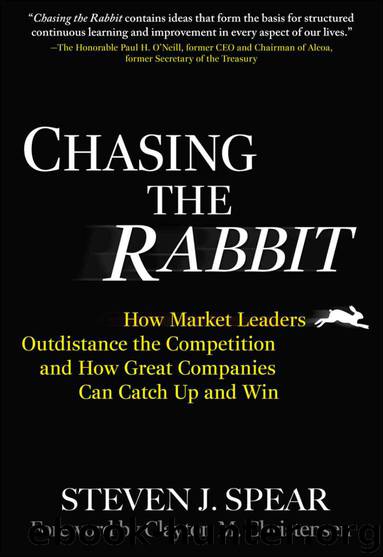Chasing the Rabbit: How Market Leaders Outdistance the Competition and How Great Companies Can Catch Up and Win, Foreword by Clay Christensen: How Market ... Up and Win, Foreword by Clay Christensen by Steven J. Spear

Author:Steven J. Spear
Language: eng
Format: mobi
Publisher: McGraw-Hill Education
Published: 2008-09-20T14:00:00+00:00
Here is an example from another Toyota supplier, NHK (Nippon Hatsujo Kabushiki Kaisha, or Japan Spring Corporation), which used the same approach to improve processes and to train workers to improve processes at the same time. We'll follow a quality circle working at a Toyota City plant, where they improved the quality of molded foam parts—the inside of armrests for the Crown, Celsior, and Lexus lines—and lowered the cost of producing them.
The quality circle had eight members, guided by a leader, Mr. Nagata, and a subleader, Mr. Mori. There were several specific problems. For example, the liner material they were using allowed the foam to bleed through the seams of the mold, resulting in time consuming, material-wasting trimming (both departures from the ideal of "immediate" and "without waste"). To resolve this issue, the quality circle didn't ping-pong, jumping to the conclusion that one or another alternative material would work. Rather, they set up a series of trials to see what material, at what thickness, would do the trick.
There was a related problem. The pin that ejected the parts from the mold had a tendency to weaken and tear the liner; this also affected quality and cost. As with the Taiheiyo quality circle, one approach might have been to delegate the problem to a technical expert or take a solution from some other armrest plant. Or they could have swapped one pin type out for another that they speculated would yield better results. However, even if this did improve the process, it would be by luck; it wouldn't develop the employees' problem-solving skills, and it wouldn't build deeper knowledge in pursuit of superlative cold-foam molding. With these multiple considerations in mind, Nagata and Mori led the team through a set of experiments, testing different combinations of pin shapes and material thicknesses to achieve the desired outcomes.
In one series, they ran 88 tests for different thicknesses of vinyl to find one that was both more durable and better at reducing leakage at the mold seams. In another series of experiments, the team adjusted the shape of the liner to achieve greater consistency. In a third set, they experimented with the number and location of ports in the mold to achieve a more even and consistent distribution of material. The experiments led to demonstrable cost and quality improvements. The defect rate was reduced by 89 percent and the number of parts that were too defective to use was reduced by two-thirds. The amount of material needed for each piece was reduced by 60 percent. And, of course, the team came to better understand its product, the material of which it was made, and the equipment used to make it.
We saw earlier that high-velocity organizations generate speed not only because they see and solve problems, but because the solutions quickly become incorporated into the best known approach—that is, the most up-to-date (and always improving) distillation of what the organization has learned collectively about how to do a particular piece of work with the best chance of success.
Download
This site does not store any files on its server. We only index and link to content provided by other sites. Please contact the content providers to delete copyright contents if any and email us, we'll remove relevant links or contents immediately.
Hit Refresh by Satya Nadella(8854)
The Compound Effect by Darren Hardy(8508)
Change Your Questions, Change Your Life by Marilee Adams(7373)
Nudge - Improving Decisions about Health, Wealth, and Happiness by Thaler Sunstein(7242)
The Black Swan by Nassim Nicholas Taleb(6764)
Deep Work by Cal Newport(6563)
Daring Greatly by Brene Brown(6225)
Rich Dad Poor Dad by Robert T. Kiyosaki(6176)
Principles: Life and Work by Ray Dalio(5961)
Man-made Catastrophes and Risk Information Concealment by Dmitry Chernov & Didier Sornette(5647)
Playing to Win_ How Strategy Really Works by A.G. Lafley & Roger L. Martin(5500)
Digital Minimalism by Cal Newport;(5389)
Big Magic: Creative Living Beyond Fear by Elizabeth Gilbert(5351)
The Myth of the Strong Leader by Archie Brown(5237)
The Slight Edge by Jeff Olson(5200)
Discipline Equals Freedom by Jocko Willink(5157)
The Motivation Myth by Jeff Haden(5003)
Stone's Rules by Roger Stone(4857)
The Laws of Human Nature by Robert Greene(4773)
